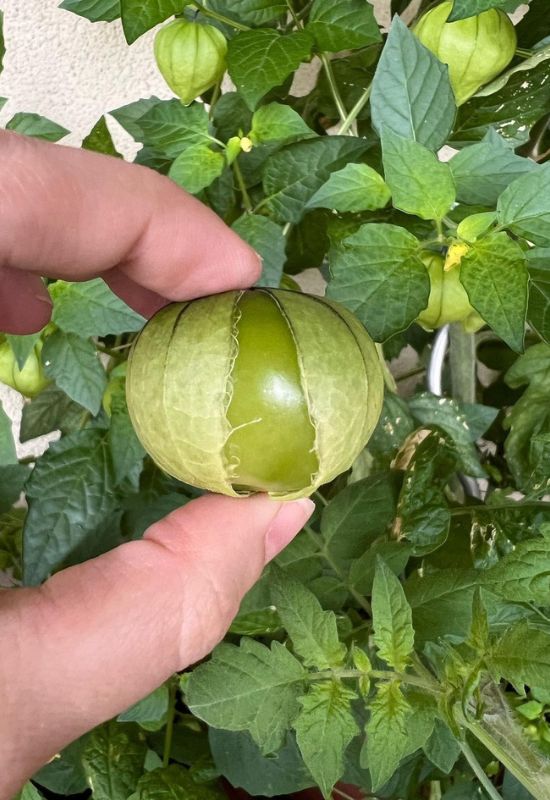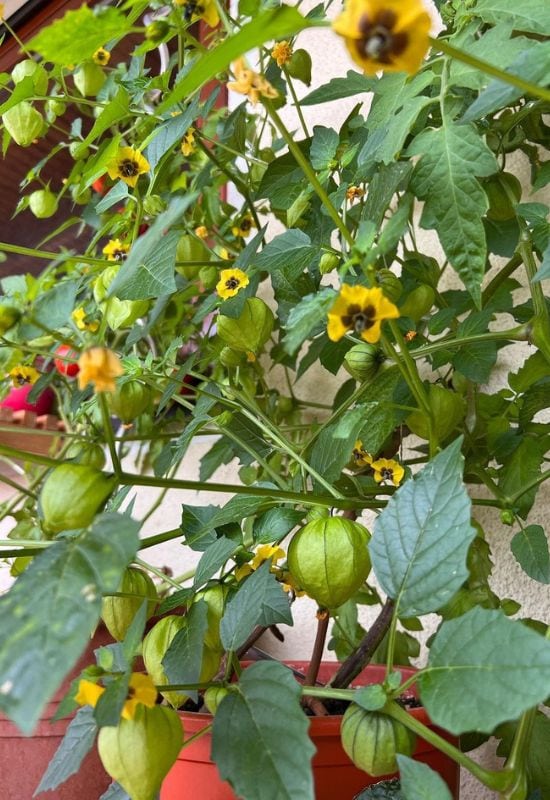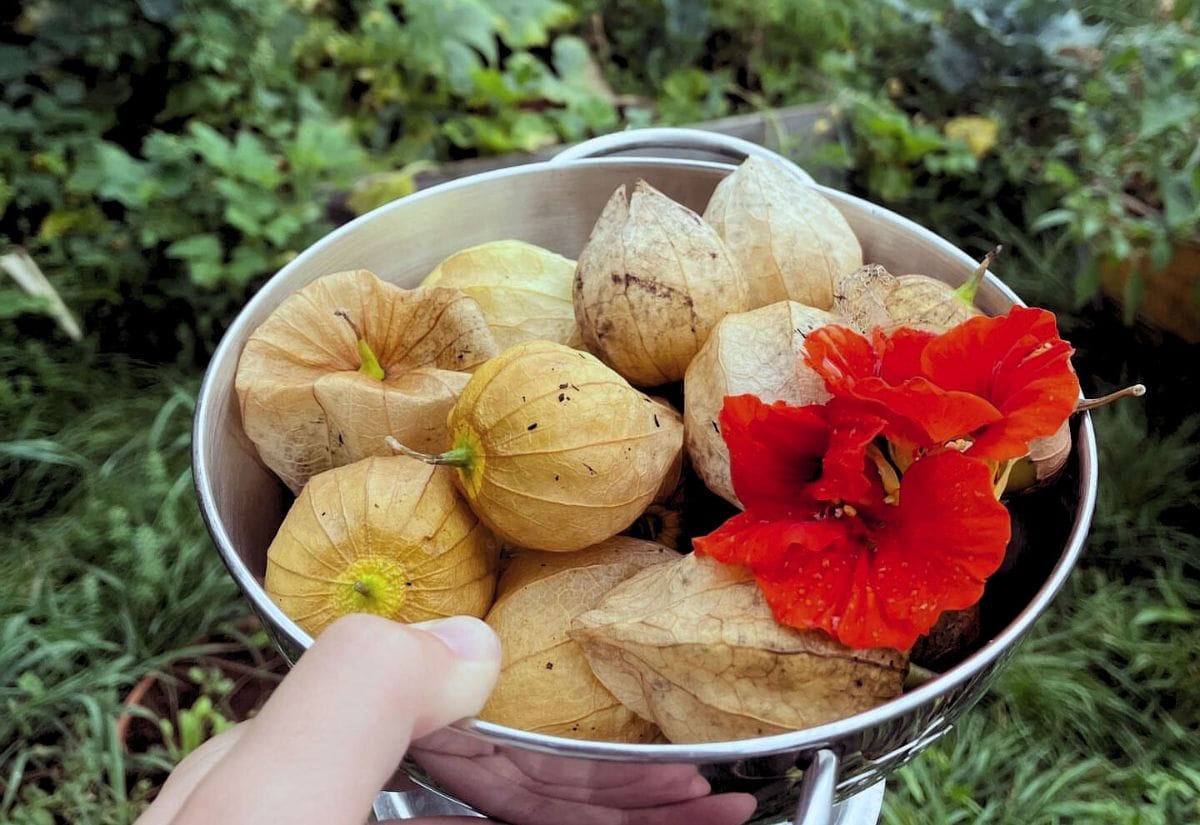
Tomatillos were first cultivated over 1500 years before the more common tomatoes, yet these tart little fruits are a bit of an enigma when it comes to harvesting. Most of us are unsure what stage they should be harvested at, or even how to tell if your tomatillo is ripe.
Typically, tomatillos mature in 75 to 100 days and can be harvested either unripe or fully ripe. An unripe tomatillo will be green and a ripe one may change to yellow or purple, though some varieties remain green. A key sign of ripeness is when the husk around a tomatillo becomes dry and papery and will be completely filled by the fruit.
Harvesting tomatillos can be puzzling, but getting the timing right is crucial because If left on the vine, a ripe tomatillo will burst the husk and drop to the ground.
Keep reading to find out how to tell when your tomatillos are ready, plus how to harvest them with tips on storage and preserving for the best flavor and quality.
All About the Tomatillo
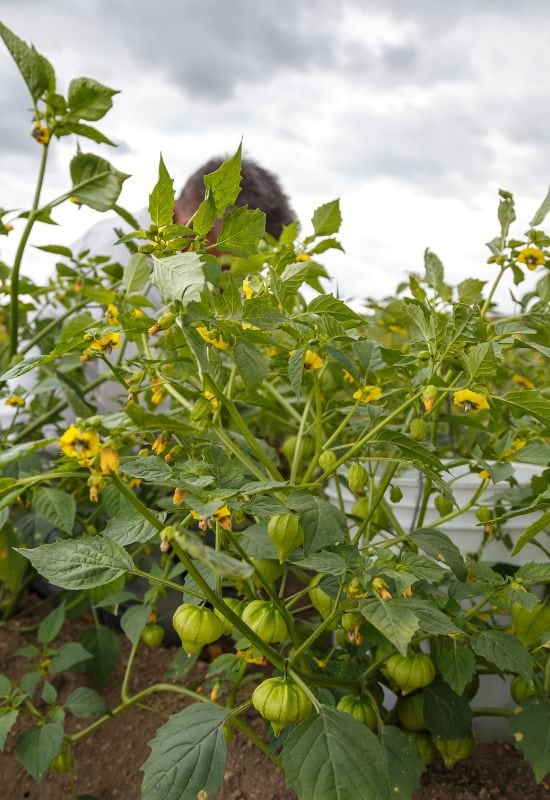
Tomatillos are part of the nightshade family, and though their name means ‘little tomato’ they share similarities with other members of the nightshade family but still have unique characteristics of their own.
Tomatillos are tropical plants from Central America and were cultivated in Mexico around 800 BC. They are hardy to Zone 10 and are usually grown as annuals.
The plants are usually around 1 meter (3 feet) tall and 60 cm (2 feet) wide, and they benefit from staking like tomatoes, or the sprawling stems will crawl along the ground and take root where they contact the soil.
The leaves of a tomatillo plant look like eggplants, but the flowers are more reminiscent of tomatoes and have 5 yellow petals with dark splotches near the stamen.
Perhaps the most unique characteristic of the tomatillo is the papery calyx, or husk, that envelopes each fruit which is why they are sometimes called “husk tomatoes”. The ripe fruits can be yellow or purple and have a distinct tart flavor.
Another unique trait of the tomatillo is that they require two plants to pollinate each other. A single plant grown on its own will not produce any tomatillos!
When to Harvest Tomatillos at Their Tastiest
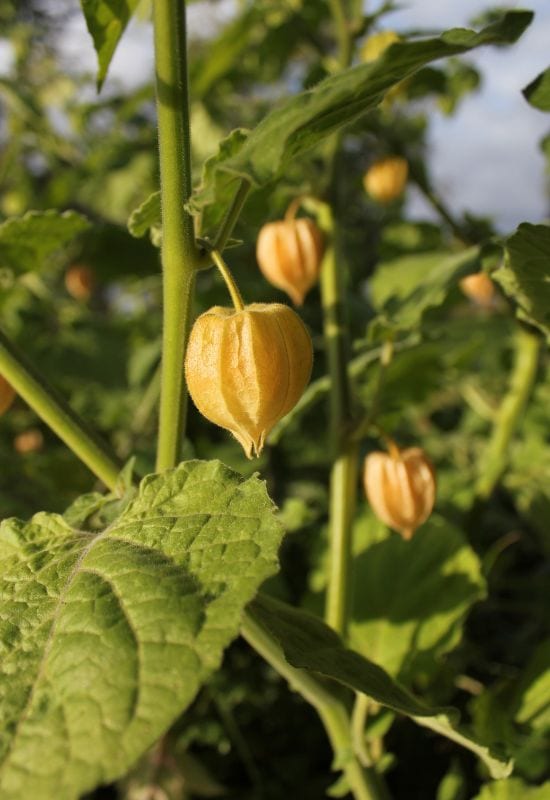
Tomatillos can be harvested while they are still green and unripe, or they can be left until they are fully ripe and fall from the plant, or anywhere in between. Here’s how to tell when your tomatillos are ready to pick.
1: Picking Unripe Tomatillos
If you’re a fan of that sharp, tangy kick, you’ll probably love your tomatillos harvested while they’re still green, nestled inside their protective husks. But here’s a tip: while these Green tomatillos can ripen off the vine, make sure you pick them when they’ve grown to their full size and are just hinting at a color change.
However, if you want a full flavored tomatillo, it is best to wait and pick them when they are fully mature yet not fully ripe.
How To Tell A Tomatillo Is Ripe for the Best Flavor
A fully ripe tomatillo will be slightly sweeter than an unripe one, but it still has a characteristic sharp flavor.
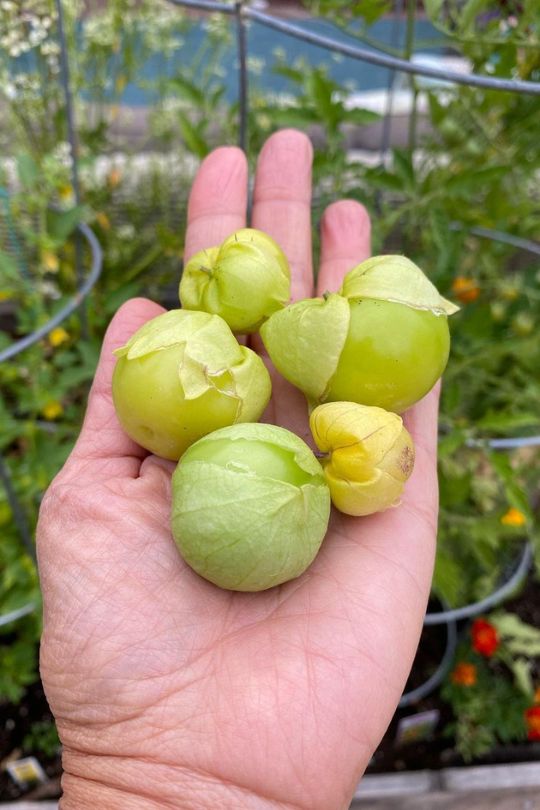
You’ll know your tomatillos are ripe when:
As tomatillos continue to ripen, they will burst the husk and often drop to the ground. This is nature’s way of reseeding itself, but you can pick them up off the ground and eat them.
How Often Can You Harvest
You can harvest tomatillos anytime they have reached the desired ripeness.
Just bear in mind that all the tomatillos on a single plant will not ripen at the same time. So, it’s a good idea to inspect your plant frequently for newly ripe fruits, letting you enjoy fresh tomatillos daily.
In terms of yield, a single tomatillo plant can produce an impressive amount—more than 1 kg (or 2.5 lbs) of fruit. That’s a range of about 60 to 200 fruits per plant, giving you plenty of opportunities to incorporate this tangy fruit into your recipes.
What Parts Of A Tomatillo Can You Eat?
When picking tomatillos, only harvest the husk-covered fruits as all other parts of the plant including the leaves, stems and flowers are are not edible. In fact, they can be toxic if ingested in large amounts, much like other members of the nightshade family. While the husks serve as a protective cover and can be helpful for storage, they aren’t edible. Ensure you peel off the husk and give the fruit a good rinse before you use it in your dishes.
How To Harvest Tomatillos
Harvest tomatillos just like how you harvest your tomatoes. Grasp the fruit (husk and all) and gently pull it off the stem. If they are fully ripe, they should come off with little effort.
If the tomatillos are still green they might be a bit more stubborn, so hold onto the stem with your free hand to avoid damaging the plant.
How To Use Tomatillos
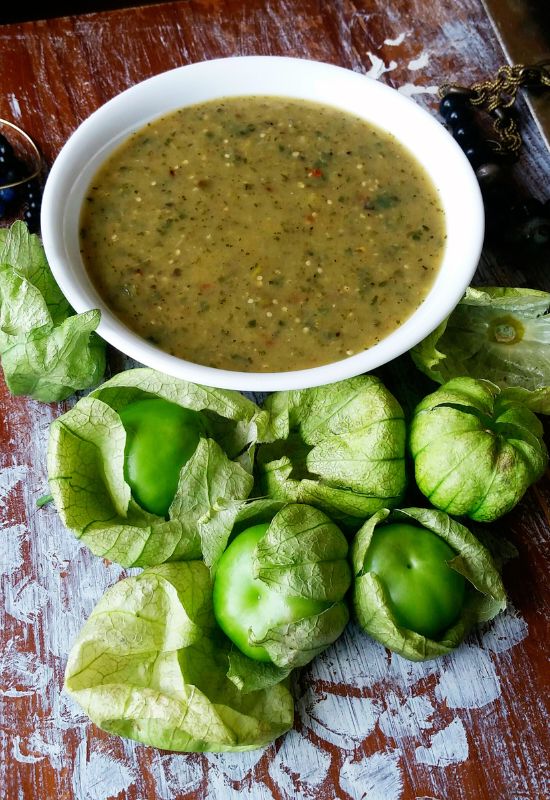
Tomatillos can be used in many different ways and dishes and they are famous for their tart, often citrusy flavor. Green, or unripe, tomatillos are the most tart, and the purple varieties are slightly sweeter than the yellow kinds.
All tomatillos can be eaten raw, but they are often cooked before use. They can be boiled by they have been found to get sweeter when they are roasted.
Salsa Verde is perhaps the most popular tomatillo dish, but they can also be used in sauces, chutneys, salsas, jams, or on nachos and enchiladas.
4 ways To Store Tomatillos
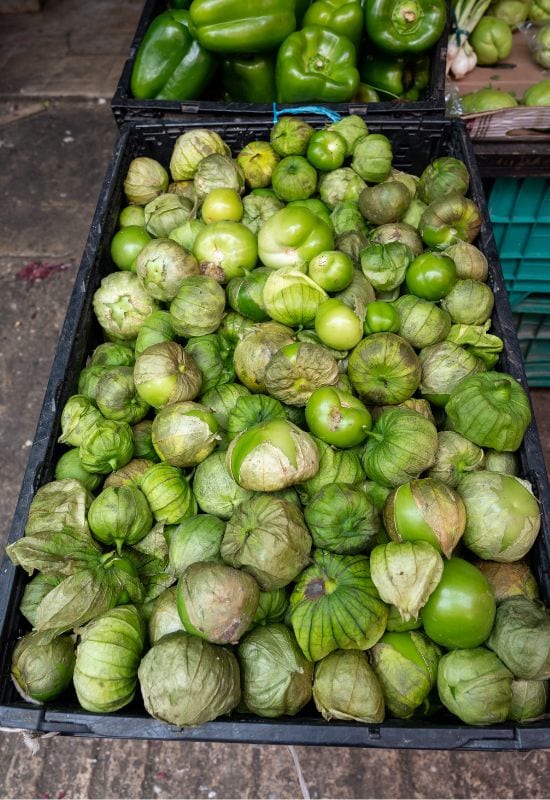
Tomatillos store very well in a variety of ways, depending on your culinary preferences.
For best results, remove the husks and wash the fruits before preserving or cooking to remove the sticky residue that forms on the fruits.
Here are the best ways to store tomatillos, whether you harvest them green or full ripe:
Fridge
Ripe or unripe tomatillos can be stored in the fridge for 2 to 3 weeks with the husks still on. Put them in a paper bag and in the crisper drawer if your fridge has one.
The ideal storage temperature for fresh tomatillos is 12°C to 15°C (55-60°F) with a relative humidity between 85% and 90%. The fruits will suffer damage if the temperature drops below 5°C (41°F).
Freezer
To freeze tomatillos, de-husk, wash and dry the fruits. Lay them on a cookie sheet lined with parchment (for easy removal). Once they are frozen, put them into a freezer bag or other container and store them for up to 6 months.
Canning
To protect yourself from Botulism and other canning-related issues, can tomatillos according to the directions of your particular canner.
You can also make salsa, jam, or other preserves and can those as well. Again, follow the directions of your canner.
Here are the guidelines from the National Centre for Home Food Preservation for how to safely can tomatillos.
Dehydrating
Tomatillos also dry nicely, and can then be stored for up to a year. Use dehydrated tomatillos as you would a sun-dried tomato.
Remove the husks, wash them, then slice the tomatillos.
As a general guideline, dehydrate tomatillos at 125°F to 135°F for 8 to 10 hours. Here is a step-by-step tutorial with pictures on how to dehydrate tomatillos.
Conclusion
If you are an experienced tomato grower, adding tomatillos might be the way to increase the diversity of your garden. These zippy fruits will also open up a whole new world of culinary creations you can make. Hopefully, with this guide, you will be able to pick them at the perfect ripeness for whatever dish you are preparing with your home-grown tomatillos.
Harvesting Tomatillo FAQ
Whether you are an experienced grower or new to tomatillos, here are answers to commonly asked questions that can help you harvest the perfect tomatillo:
Q: Are tomatillos and tomatoes the same thing?
A: No. Even though the word tomatillo means little tomato, and they are sometimes called Mexicanhusk tomatoes, tomatillos and tomatoes are NOT the same plant. They are, however, both part of the nightshade family.
Q: Are tomatillos and ground cherries the same thing?
A: No. Though they look similar and both have papery husks around the fruits, ground cherries are significantly sweeter than tomatillos and are often eaten raw.
Q: Can you harvest tomatillos early?
A: Yes, tomatillos can be picked before they are mature. They can be harvested at any point of their growth.
Q: Can you eat unripe tomatillos?
A: Yes. Tomatillos are very popular to eat green. Unripe tomatillos are very tart.
Q: Will tomatillos ripen off the vine?
A: Yes. Like tomatoes, tomatillos can ripen off the vine. If tomatillos are picked mature and just starting to blush, they will often ripen indoors.
Q: Why is a tomatillo husk empty?
A: Empty husks are usually caused by poor pollination. Tomatillos cannot pollinate themselves, so they require two or more plants to pollinate. If there is no other plant nearby, it is common to find empty husks on your plant.
Q: My tomatillos are falling off the plant. Can I still eat them?
A: Yes, you can! When tomatillos drop off the plant, this means that they are fully ripe and ready to eat. Just gather them off the ground and enjoy.
Q: What color are ripe tomatillos?
A: Ripe tomatillos are either yellow (or yellow-green) or they can be purple depending on the variety you are growing. Unripe tomatillos are green.
Q: My tomatillos are sticky and have a black goop. Are they still okay to eat?
A: Yes, most tomatillos will have a sticky residue on them and an occasional black goop as well. Wash them well to remove and enjoy!

Written By
Amber Noyes
Amber Noyes was born and raised in a suburban California town, San Mateo. She holds a master’s degree in horticulture from the University of California as well as a BS in Biology from the University of San Francisco. With experience working on an organic farm, water conservation research, farmers’ markets, and plant nursery, she understands what makes plants thrive and how we can better understand the connection between microclimate and plant health. When she’s not on the land, Amber loves informing people of new ideas/things related to gardening, especially organic gardening, houseplants, and growing plants in a small space.

